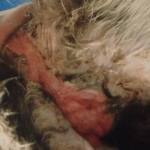Identification no longer needs a collar. Microchipping is safer and more effective. Update your cat flap with the new microchip operated ones – www.sureflap.co.uk and Staywell PetPorte. Never use flea collars. Spot on products are safer and more effective. However, you can put a GPS unit on a collar if you want to keep track of your cat, but only do this if it is really necessary. Google for people who sell them. Just putting on a collar because it looks nice can endanger the life of your cat (Arhant et al 2022). Some very glamorous looking collars are downright dangerous even on a cat living indoors. Collar injuries are much rarer than road accidents but then collar-wearing cats are rarer than those without collars (Calver et al., 2013). People who don’t use collars think the risks outweigh the benefits (Arhand et al., 2023)

Collar injury. Kevin was rescued by Sunshine Cat Rescue in 2016. He had caught his leg in his collar and it had cut his neck almost to the bone. He died from this. c. Brian Woolford.
Collars with elastic inserts are dangerous, particularly if they are loose fitting. Cats can get their paws stuck in it or may be half hung if it catches on a branch etc or on a piece of furniture.. The elastic just doesn’t give enough if the weight is on it. During seven years one cat rescue in the UK had five cases where cats were in distress because of collars – two injured legs; one lost and emaciated; one stuck in a tree upside down, and one hanging from a low branch quite unable to extricate itself. The Mayhew Animal Home had to operate on a cat in 2015 that had got its leg stuck in a “stretch rubber” collar so long that the collar was embedded in its flesh. Cat owners who try collars often don’t continue to use them because of perceived risks (Arhant et al., 2024)
Quick-release or snap collars are safer than elastic ones. Choose a collar in a soft material (not leather), well made, no sharp bits. Look for a quick-release buckle. Test this. If you can’t open it easily, then it is too stiff to be quick-release. If your cat occasionally loses its collar, then this is collar design where the quick-release buckle really works. The collar should be neither too tight nor too loose. You should be able to get one or two fingers into it. There is a useful video of how to fit a collar here.
Specialist collars can reduce or even stop cats killing birds and mice. Cat bells had no effect in a study published in 2021 (Cecchetti et al, 2021). Teeth and claws can get stuck in the bell. CatAlert collar which emits a bleep when the cat pounces had a better reduction in prey than a collar with a bell or two bells (Nelson et al., 2005) but I cannot find a supplier. The Cat Bib (Calver et al., 2007) seems effective. It fits on an ordinary collar so it requires care with the collar (not the device itself). There is also the bright Birdsbesafe® collar, which looks very promising (Wilson et al., 2015).
But you can do other things instead. Keep your cat indoors for dawn and dusk. Careful siting of bird tables etc will also help reduce casualties – more detail here from the RSPB. Put scrunched up wire netting under shrubs if your cat is using these to ambush ground-feeding birds.
You can also influence your cat to reduce its hunting. Feed food high in meat content and give your cat regular play with fishing rod toys. Birdsbesafe collars reduced bird casualties but had no effect on other animals.
REFERENCES
Arhand, C., Heizmann, V., Schauberger, G. & Windschnurer, I., (2022), “Risks and benefits of collar use in cats (Felis catus): a literature review,” Journal of Veterinary Behavior, https://doi.org/10.1016/j.jveb.2022.07.012
Arhand, C., Lesch, R., Heizmann, V., Schauberger, G. & Windschnurer, I., (2024),”Attitudes towards cat collar use in central European cat owners – an online survey,” Journal of Veterinary Behavior, https://doi.org/10.1016/j.jveb.2024.06.004
Calver, M., Thomas, S., Bradley, S. & McCutcheon, H., (2007), ‘Reducing the rate of predation on wildlife by pet cats: The efficacy and practicability of collar-mounted pounce protectors,’ Biological Conservation, 137, 3411-348.
Calver, M., Adams, G., Clark, W. & Poock K. H., (2013), ‘Assessing the safety of collars used to attach predation deterrent devices and ID tags to pet cats,’ Animal Welfare, 22, 95-105. Abstract.
Cecchetti, M., Crowley, S. L., Goodwin, C. E. D & MacDonald, R. A., (2021), “Provision of High Meat Content food and Object Play Reduce Predation of Wild Animals by Domestic Cats, Felis catus,”Current Biology 31, 1107–1111.
Nelson, S., Evans, A. D., & Bradbury, R. B., (2005), ‘The efficacy of collar-mounted devices in reducing the rate of predation of wildlife by domestic cats,’ Applied Animal Behaviour Science 94, 273–285
Wilson, S. K., Okunlola, I. A. & Novak, J. A., (2015), ‘Birds be safe: Can a novel cat collar reduce avian mortality by domestic cats (Felis catus)’? Global Ecology and Conservation, 3, 359-366.